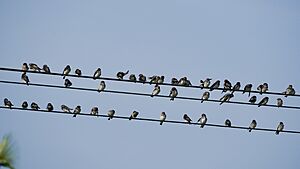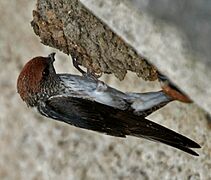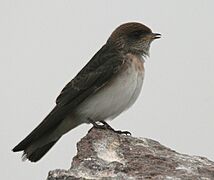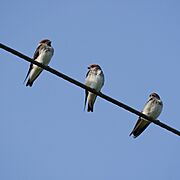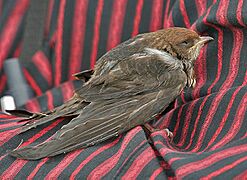Streak-throated swallow facts for kids
Quick facts for kids Streak-throated swallow |
|
|---|---|
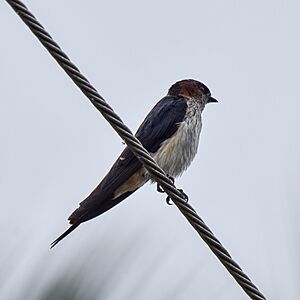 |
|
| Conservation status | |
| Scientific classification | |
| Genus: |
Petrochelidon
|
| Species: |
fluvicola
|
| Synonyms | |
|
|
The streak-throated swallow (also known as the Indian cliff swallow) is a small, fast-flying bird. It is a type of passerine bird, which means it belongs to a large group of perching birds. This bird is native to South Asia. It lives there all year round, or visits during certain seasons. You can find it in countries like India, Pakistan, Nepal, and Afghanistan. Sometimes, it can even be seen as far away as the Maldives or Sri Lanka.
About This Bird
The streak-throated swallow was first described by an English scientist named Edward Blyth in 1855. It is part of a group of birds called Petrochelidon. This group was named by a German bird expert, Jean Cabanis, in 1850. All swallows, including this one, belong to the Hirundinidae family.
What It Looks Like
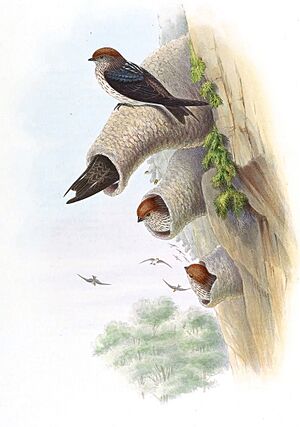
The streak-throated swallow is about 11 centimeters (4.3 inches) long. This makes it about the size of a sparrow. It has a dull brown-red forehead and the top of its head. Its belly and chest are whitish. The feathers on its back are a shiny steel-blue color. Its rump (the area above its tail) is light brown, and its tail has a square shape at the end.
A special feature of this bird is the brown streaks on its throat and chest. These streaks help tell it apart from other similar birds. On cool mornings, you might see many of these swallows packed closely together on electric wires. They do this to warm up in the early sun. When perched, they make a soft, twittering chirp sound. When they fly, they make a sharp trr-trr sound.
Where It Lives
The streak-throated swallow lives in many parts of South Asia all year. You can find it from the plains of Pakistan all the way east to Sikkim, near the Himalayas. Its home range also goes south through India to Point Calimere in Tamil Nadu.
These birds like to live in large groups. They are often found in farm fields and open areas. They prefer places close to water, such as ponds, lakes, canals, and rivers.
How They Live
Streak-throated swallows eat tiny flying insects. They catch these insects, like midges, while flying in the air. They can build nests almost all year. Their nesting season runs from December to April and again from July to October.
These birds build large nests made of mud. Many pot-shaped nests are joined together to form a big colony. Each nest has a short tube for an entrance.
Swallows often stay in the same places. This might be because of how close they are to food sources. For example, in a college in Rajasthan, India, a group of these swallows built a nest colony. It was about 9 meters (30 feet) high, under the roof. In October 2010, the nests were destroyed when the building was being fixed. But within just four days, the birds started building new nests. They finished the whole colony in four months! Even when their nests were cleaned away each year, the swallows always came back to the same spot and rebuilt their home.
Gallery



